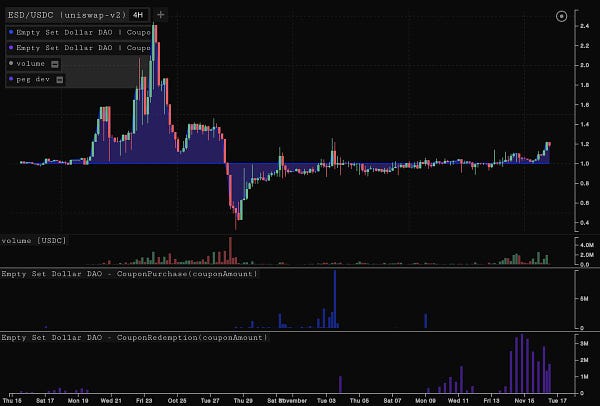Note: The DXdao* community is excited to announce the alpha launch of Swapr, making DXdao the first DAO on Ethereum to launch a DeFi protocol. Swapr is a governance-enabled AMM based of a fork of Uniswap that allows for adjustable fees through governance. Read the announcement for more info or follow Swapr on Twitter.
It’s been just two months since Uniswap launched UNI. Discussion on the surprise launch centered around the retroactive UNI awards to every Uniswap user and the liquidity mining program that targeted the ETH/WBTC and ETH/stablecoin pools, but the UNI announcement also set those rewards to expire today.
The four incentivized pools accounted for $2.2bn of Uniswap’s $3.1bn of total deposits (numbers before UNI reward deprecation).
UNI governance has been….limited to say the least. It has not passed any proposals and has actually failed to meet quorum for a vote. Of course, the Uniswap team and prominent investors are absent, but the community is trying to rally around a proposal to keep the “status quo”.


There is strong evidence that UNI rewards are incentivizing more liquidity than they need to. Attracting assets into Uniswap is only good if the enable additional volume. The UNI incentive program has made Uniswap competitive to centralized exchanges on ETH/stablecoin and ETH/WBTC trades.
But does it need an $800m ETH/WBTC pool? If the the same volume be generated on a $400m pool, then why spend UNI attracting vanity assets?
There is currently a Snapshot vote for a ‘Temperate Check’ on the proposal from Cooper and Monet Supply to halve the UNI rewards. The vote is 65% in favor right now, but it still needs several thousand more UNI to reach quorum.
Sushi time, again?

You don’t need to be Jiro to understand the logic behind Sushiswap’s latest reward strategy. It’s going after Uniswap LPs who have seen their UNI supply cut off.
And it appears to be working. Hours after the rewards stopped, hundreds of millions of dollars worth of assets flowed from Uniswap to Sushsiswap, particularly in the ETH/WBTC. The Uniswap pool lost 50% of its TVL($350m), while Sushiswap has seen more than $100m added to its ETH/WBTC pool.
What’s next?
Perhaps another round of liquidity fleeing Uniswap will motivate UNI voters to take action. Plus, there has been more and more UNI distributed, so it should be easier to reach quorum. Reinstatement of the “status quo” is most probable, but its hard to see UNI governance agreeing on much else.
Fees from Uniswap may be stickier than liquidity. Uniswap continues to drive price discovery, and an LP migration won’t materially affect traffic to Uniswap.exchange. Fee returns provide a floor for the incentivized pools, because as LPs exit, the share of fees to existing LPs increases.
Related: Governance tokens in pools can vote too
[CRV/YFI] Establish who votes in Curve DAO on behalf of Yearn
[UNI/COMP] Compound’s UNI pool is 4th largest Uniswap delegate
[INDEX/DPI] IIP-8 Meta Governance Module
Tweet of the Week: Empty Set Dollar in Action


Empty Set Dollar is the latest DeFi galaxy-brain project, or ‘sci-finance’ as Parsec’s Will Sheehan puts it. Empty Set was launched by an anonymous team at the end of August and builds on the elastic supply model pioneered by Ampleforth, but aims to make rebases less disruptive by abstracting them away. If ESD is trading above $1.00, instead of a positive rebase for the whole supply, it mints new ESD and directs it ESD staked in the DAO, and if ESD is trading below $1.00, instead of a negative rebase, it issues coupons “redeemable for a premium quantity of future ESD” to those that burn ESD. Check out the easy-to-read whitepaper in full.
In the chart in the Tweet above, the second-to-bottom row of bars are coupons that were purchased when ESD traded below $1.00 during the first week of November, and then the bottom of row of bars shows those coupons being redeemed the past week, now that ESD is above its peg. Interest growing in ESD. Will Price and DeFi Pulse’s Scott Lewis penned a proposal to make the coupon mechanism more enticing because “effective hawkish tools are needed to stabilize [the peg] during periods of weakness.” Clearly, lessons are being learned from Maker’s struggle to defend the peg earlier this spring.
Chart of the Week: YFI on the move
Chart from Nansen’s Alex Svanevik in the invaluable Our Network newsletter. The chart shows the decline of YFI deposits in Aave over the last two and a half months from a high of 8,356 YFI to just 2,119 YFI currently. Presumably, some of this was due to Zeus Capital’s (failed) YFI short, but some of the YFI has made its way to MakerDAO, after it approved YFI as acceptable collateral to open a Dai loan. YFI already hit its $7m debt-ceiling with almost 4% of all YFI currently in Maker - only 2.3% of ETH is locked in Maker now. Aave has grown because it accepts a long tail of assets as collateral. That can lead to churn later as assets disperse into late-arriving competitors.
Odds and Ends
DXdao* Month in Review Link
Argent’s Learn about DeFi guide Link
Humingbot introduces Balancer connector and arbitrage strategy Link
Akropolis’s Delphi Savings Pool Exploit post-mortem Link
Oracle project API3 closes $3m round led by Placeholder Link
sOIL and iOIL now live on Synthetix Link
UMA spins off uLabs to focus on financial products Link
Thoughts and Prognostications
Feedback Control as a New Primitive for DeFi [Hsien-Tang Kao and Tarun Chitra]
Interview with a Spartan [Degenspartan & Hasu/Uncommon Core]
AMMs and capital efficiency [Kyle Samani/Multicoin]
Aave governance rundown [Marc Zeller/Aave]
That’s it! Feedback appreciated. Just hit reply. Written in Nashville! Nice drive down south.
Dose of DeFi is written by Chris Powers. Opinions expressed are my own. I spend most of my time contributing to DXdao*. All content is for informational purposes and is not intended as investment advice.



